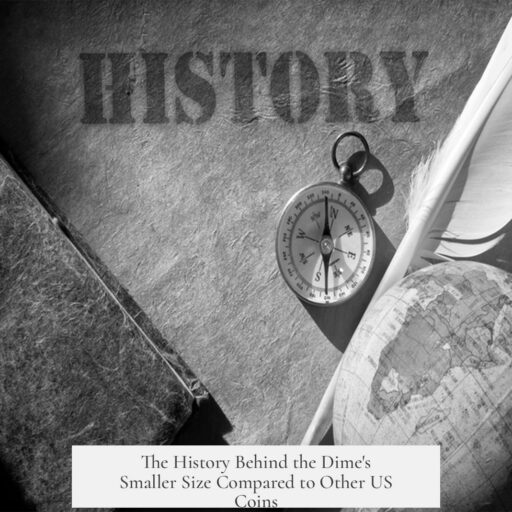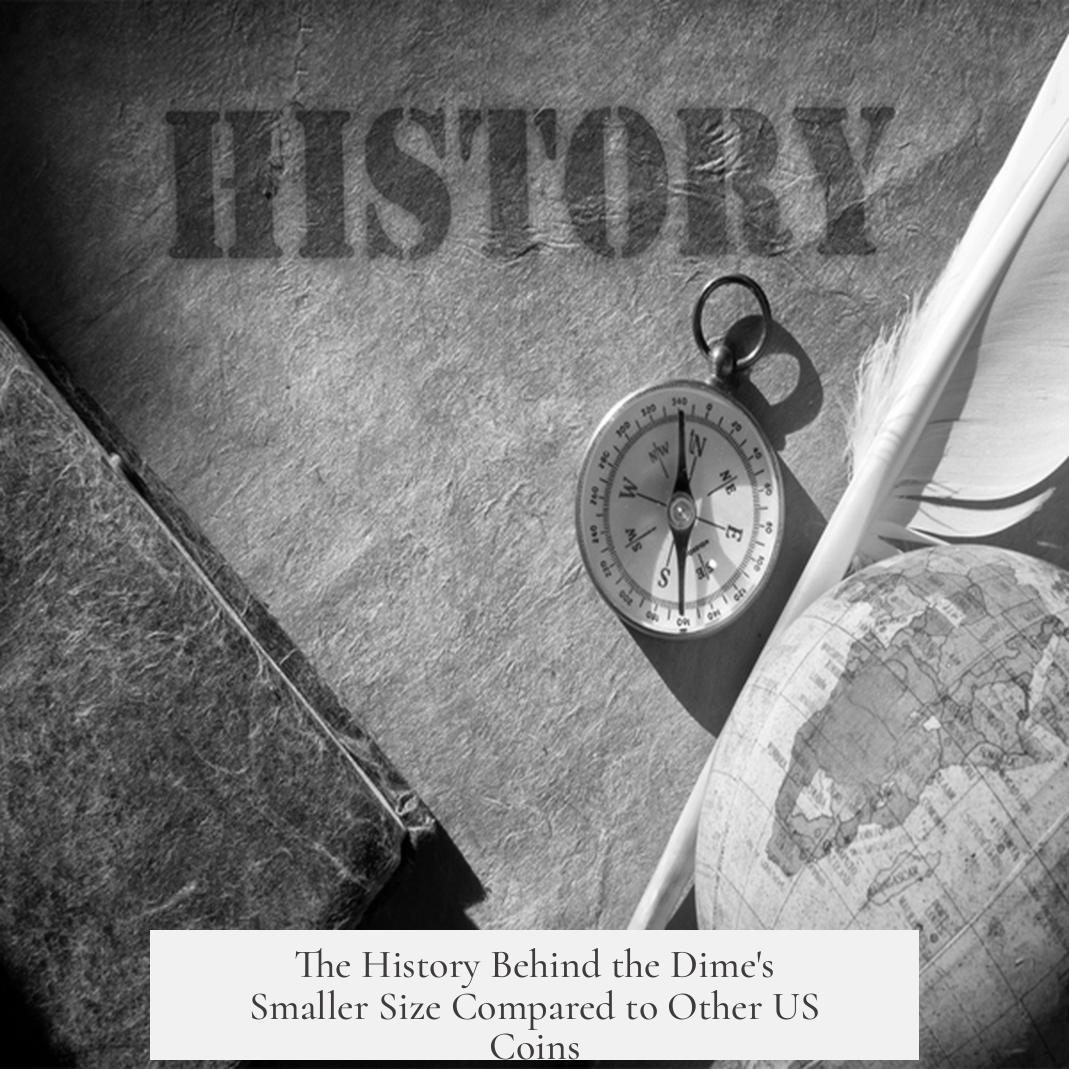The idea to make dimes smaller than pennies, nickels, and quarters stems from the original design principle aligning coin size with intrinsic silver content and monetary value. Early U.S. coins used silver content to determine size and value. The dime contained 10% of a dollar’s worth of silver, naturally making it smaller than coins with higher silver value, such as the quarter or half-dollar. Meanwhile, the penny was copper, initially larger but less valuable in metal content.

At the nation’s founding, the dollar, half-dollar, quarter, dime, and half-dime were silver coins. Their weights and sizes reflected proportional silver content. For example, a dollar had one full dollar’s worth of silver, a quarter had one-quarter of that, and the dime had one-tenth.
- The “dime,” from Latin meaning “tenth,” contained 10% of a dollar’s silver value.
- The half-dime was even smaller but proved impractical due to its tiny size.
- The penny was a large copper coin; copper’s value did not linearly correlate to the other silver coins.
This proportional approach explains why the dime is smaller than the penny, nickel, and quarter. The silver content necessitated a smaller physical size for the dime, representing its lower denomination and metal value. The half-dime’s impractical size demonstrated limits to how small coins could be while still usable.

Later, the issue of bullion versus face value arose. In the 19th century, silver coins often held more value as metal than their face value. This caused coins to leave circulation, melted down or sold overseas. To counteract this, the U.S. adjusted silver content in 1853, dropping precious metal content but keeping sizes proportional to their new metal composition and denomination.
The half-dime was eventually replaced by the nickel, a copper-nickel alloy coin, which was larger (in both size and weight) than the dime. This shows a shift in material but maintained relative sizes tied to denominations.

By the mid-20th century, inflation pushed the face value of silver coins below their metal value, threatening circulation again. The U.S. resolved this in the 1960s by producing coins in base metals yet keeping the familiar sizes of existing coins, including the dime’s smaller size.
Throughout these changes, the dime’s smaller size persisted, rooted in its original silver content and denomination value. No single person is credited with the idea; rather, it evolved from early U.S. minting practices prioritizing metallic value proportions.

| Coin | Metal Content | Value Relation | Size Explanation |
|---|---|---|---|
| Dime | Originally 90% silver | 10% of a dollar | Correspondingly smaller size |
| Penny | Copper | 1% of a dollar | Larger size for practicality |
| Nickel | Copper-Nickel alloy | 5 cents | Larger than dime; replaced half-dime |
| Quarter | Originally 90% silver | 25% of a dollar | Medium size for value |
The persistent small size of the dime also reflects practical considerations. Coins must be large enough to handle but not so large as to be cumbersome. The half-dime’s tiny size proved impractical, so the dime represents a balance.
The Victorian-era principle was to keep physical size, weight, and metal content proportional to value to facilitate commerce and coin recognition. This principle shaped the dime’s uniquely small size among U.S. coins.

- The dime’s size corresponds to 10% of a dollar’s silver value, explaining why it is smaller than higher-value coins.
- The penny’s copper composition and purpose led to its larger, more practical size despite lower intrinsic value.
- When silver was removed from circulation coins, traditional sizes were maintained for familiarity.
- No single inventor of the dime’s smaller size; the design evolved from early proportionality principles.
Who Had the Idea to Make Dimes Smaller Than a Penny, Nickel, and Quarter?
Here’s the straightforward answer: The size of coins like the dime, penny, nickel, and quarter wasn’t randomly chosen by someone doodling on a scrap of paper. Instead, it evolved from a system where the coin’s size was directly tied to its silver content and value. So, dimes ended up smaller than pennies, nickels, and quarters because they originally contained less silver, roughly 10% the value of a dollar, and their size reflected that.

Sounds a bit odd, right? You’d think a dime, worth 10 cents, should at least be bigger than a penny, worth just one cent. But history paints a different story—one that’s rooted deeply in economics, precious metals, and practicality.
The Silver Standard: Size Means Value

Picture this: it’s the early days of the United States. Coins like the dollar, half-dollar, quarter, and dime were made almost entirely from silver. The idea was simple and elegant. Each coin contained an amount of silver proportional to its face value.
- The dollar carried a dollar’s worth of silver.
- The quarter held one-fourth of that silver.
- The dime included a tenth of a dollar’s silver, hence the name dime, derived from the Latin decimus, meaning “tenth.”
In this system, the dime had to be physically smaller because it held less silver. Meanwhile, the penny was made of copper—valued at roughly 1% of a dollar. However, the original penny was quite large, which wasn’t very practical for everyday use. This juxtaposition between precious and base metal really set the stage for the sizes we see today.
Oh, and there was even a half-dime once. It was so tiny it barely fit in your pocket, making it essentially impractical. That coin faded out.
Challenges in Silver Coinage and the Birth of the Nickel
As America matured, coins faced a curious problem: European silver was cheaper. American silver coins were surprisingly more valuable when you melted them down for their metal alone. This led to a mass exodus of silver coins, disappearing from US circulation and popping up in Europe instead.
The government had to act fast. In 1853, U.S. officials reduced the silver content in coins. They kept the silver content high but not fully “face-value equivalent” to silver’s market price, aiming to keep coins circulating and avoid hoarding or melting.
They struck coins with 90% silver but adjusted values and weight to keep sizes proportional. During this era, the nickel emerged, made from a copper-nickel alloy, replacing the tiny half-dime because it was a better size and less prone to melting down for metal value.
As for the penny, the US crafted it smaller than before, using copper but scaled down to a size more manageable for commerce. Thus, smaller coins did not mean lesser value on their own, but a result of balancing content, value, and physical practicality.
Inflation Hits: Silver’s Shine Loses Its Luster
Fast forward to the mid-1960s. Inflation kicks in, and silver’s price rises sharply. The coins’ metal became worth more than their face value, creating a real headache. Suddenly, it was profitable to melt coins down, threatening the coin supply all over again.
What did the U.S. do? They turned to base metals. The silver coins remained the same size and looked the same (they still sported a silvery shine) but no longer contained precious metals. The dime, quarter, half-dollar, and dollar coins transitioned to copper-nickel blends or clad metals, keeping their familiar sizes intact.
This was smart economics. By holding onto size and appearance, citizens adapted quickly, and commerce flowed without disruption. And as a bonus, the dime stayed small, a nod to its origin with silver content representing roughly 10% the value of a dollar.
Why Is This Important to Know?
You might wonder why such an attention to metal content and coin size? Understanding this history helps explain why the dime is smaller than the penny, nickel, and quarter—something many find puzzling.
Besides satisfying curiosity, it shows how currency design reflects not just aesthetics but economics, metals markets, and practical uses. The story of the dime is really the story of America’s evolving economy and the challenges of keeping money circulating fairly.
Practical Tips for Collectors and Curious Minds
- If you collect coins, knowing the history behind their size and metal content adds a layer of appreciation.
- Recognize that older silver coins are more valuable for their metal, often worth more than face value.
- Modern coins keep historical sizes and colors but lack precious metals, so don’t melt them for silver!
Next time you pull out a dime and wonder why it’s tiny next to a penny, remember: it’s old economics, silver content, and good old-fashioned practicality at work.
Summary Table: Coin Evolution
| Coin | Original Metal | Value in Silver Content | Size Reason | Modern Material |
|---|---|---|---|---|
| Dime | Silver (90%) | 10% of $1 (10 cents) | Smaller because less silver | Copper-nickel clad |
| Penny | Copper | 1% of $1 (1 cent) | Smaller for practicality | Copper-plated zinc |
| Nickel | Copper-nickel | 5 cents face value | Larger replacing half dime | Copper-nickel alloy |
| Quarter | Silver (90%) | 25 cents | Proportionate to value | Copper-nickel clad |
Final Food for Thought
Coins are more than just shiny pieces you toss into a fountain wishing for luck. They are historical artifacts reflecting economic policies, metal markets, and practical challenges of everyday commerce. The tiny dime is a perfect example of that balance—small in size, but rich in history and meaning.
Next time you gaze at a dime and wonder, “Who made this tiny coin smaller than the penny?” remember—it was less a single person’s whim and more a clever economic design shaped by history and metal markets.
Why is the dime smaller than the penny, nickel, and quarter?
The dime was designed to be smaller because it originally contained 10% of a dollar’s worth of silver. Its size reflected its intrinsic value, making it naturally smaller than larger denomination coins with more silver content.
Who decided that coin sizes should be proportional to their silver content?
No single person is credited with this idea. It was a design principle followed by the U.S. Mint to match coins’ sizes and weights with their silver content and face value for practical and economic reasons.
Why was the half-dime coin discontinued even though it was smaller than the dime?
The half-dime was too small to be practical. Its tiny size made it difficult to use, so it was eventually replaced by the larger copper-nickel nickel, balancing usability with value.
Did the dime remain smaller even after silver was removed from U.S. coins?
Yes, when the U.S. switched to base metals in the 1960s, the dime kept its original smaller size. The change focused on metal content, not altering the familiar coin sizes.
Was there any attempt to make pennies smaller than dimes?
The penny was originally larger and made of copper, representing 1% of a dollar’s value. It was later reduced in size but never made smaller than the dime, which maintained its distinct smaller shape linked to its value.




